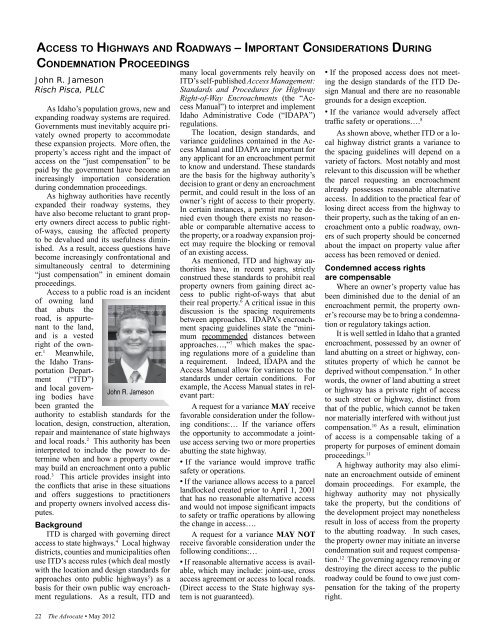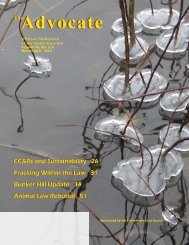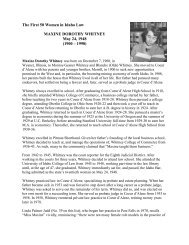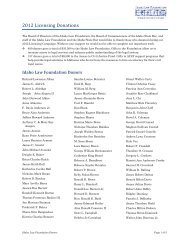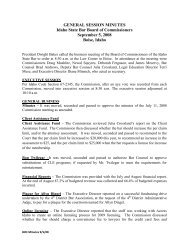The Advocate - May 2012 - Idaho State Bar - Idaho.gov
The Advocate - May 2012 - Idaho State Bar - Idaho.gov
The Advocate - May 2012 - Idaho State Bar - Idaho.gov
Create successful ePaper yourself
Turn your PDF publications into a flip-book with our unique Google optimized e-Paper software.
aC C e s s t o hi g hW a y s a n d ro a d W a y s – iM P o r ta n t Co n s i d e r at i o n s du r i n g<br />
Co n d e M n at i o n Pr o C e e d i n g s<br />
John R. Jameson<br />
Risch Pisca, PLLC<br />
As <strong>Idaho</strong>’s population grows, new and<br />
expanding roadway systems are required.<br />
Governments must inevitably acquire privately<br />
owned property to accommodate<br />
these expansion projects. More often, the<br />
property’s access right and the impact of<br />
access on the “just compensation” to be<br />
paid by the <strong>gov</strong>ernment have become an<br />
increasingly importation consideration<br />
during condemnation proceedings.<br />
As highway authorities have recently<br />
expanded their roadway systems, they<br />
have also become reluctant to grant property<br />
owners direct access to public rightof-ways,<br />
causing the affected property<br />
to be devalued and its usefulness diminished.<br />
As a result, access questions have<br />
become increasingly confrontational and<br />
simultaneously central to determining<br />
“just compensation” in eminent domain<br />
proceedings.<br />
Access to a public road is an incident<br />
of owning land<br />
that abuts the<br />
road, is appurtenant<br />
to the land,<br />
and is a vested<br />
right of the owner.<br />
1 Meanwhile,<br />
the <strong>Idaho</strong> TransportationDepartment<br />
(“ITD”)<br />
and local <strong>gov</strong>erning<br />
bodies have<br />
been granted the<br />
authority to establish standards for the<br />
location, design, construction, alteration,<br />
repair and maintenance of state highways<br />
and local roads. 2 This authority has been<br />
interpreted to include the power to determine<br />
when and how a property owner<br />
may build an encroachment onto a public<br />
road. 3 This article provides insight into<br />
the conflicts that arise in these situations<br />
and offers suggestions to practitioners<br />
and property owners involved access disputes.<br />
Background<br />
ITD is charged with <strong>gov</strong>erning direct<br />
access to state highways. 4 Local highway<br />
districts, counties and municipalities often<br />
use ITD’s access rules (which deal mostly<br />
with the location and design standards for<br />
approaches onto public highways 5 ) as a<br />
basis for their own public way encroachment<br />
regulations. As a result, ITD and<br />
22 <strong>The</strong> <strong>Advocate</strong> • <strong>May</strong> <strong>2012</strong><br />
John R. Jameson<br />
many local <strong>gov</strong>ernments rely heavily on<br />
ITD’s self-published Access Management:<br />
Standards and Procedures for Highway<br />
Right-of-Way Encroachments (the “Access<br />
Manual”) to interpret and implement<br />
<strong>Idaho</strong> Administrative Code (“IDAPA”)<br />
regulations.<br />
<strong>The</strong> location, design standards, and<br />
variance guidelines contained in the Access<br />
Manual and IDAPA are important for<br />
any applicant for an encroachment permit<br />
to know and understand. <strong>The</strong>se standards<br />
are the basis for the highway authority’s<br />
decision to grant or deny an encroachment<br />
permit, and could result in the loss of an<br />
owner’s right of access to their property.<br />
In certain instances, a permit may be denied<br />
even though there exists no reasonable<br />
or comparable alternative access to<br />
the property, or a roadway expansion project<br />
may require the blocking or removal<br />
of an existing access.<br />
As mentioned, ITD and highway authorities<br />
have, in recent years, strictly<br />
construed these standards to prohibit real<br />
property owners from gaining direct access<br />
to public right-of-ways that abut<br />
their real property. 6 A critical issue in this<br />
discussion is the spacing requirements<br />
between approaches. IDAPA’s encroachment<br />
spacing guidelines state the “minimum<br />
recommended distances between<br />
approaches…,” 7 which makes the spacing<br />
regulations more of a guideline than<br />
a requirement. Indeed, IDAPA and the<br />
Access Manual allow for variances to the<br />
standards under certain conditions. For<br />
example, the Access Manual states in relevant<br />
part:<br />
A request for a variance MAY receive<br />
favorable consideration under the following<br />
conditions:… If the variance offers<br />
the opportunity to accommodate a jointuse<br />
access serving two or more properties<br />
abutting the state highway.<br />
● If the variance would improve traffic<br />
safety or operations.<br />
● If the variance allows access to a parcel<br />
landlocked created prior to April 1, 2001<br />
that has no reasonable alternative access<br />
and would not impose significant impacts<br />
to safety or traffic operations by allowing<br />
the change in access….<br />
A request for a variance MAY NOT<br />
receive favorable consideration under the<br />
following conditions:…<br />
● If reasonable alternative access is available,<br />
which may include: joint-use, cross<br />
access agreement or access to local roads.<br />
(Direct access to the <strong>State</strong> highway system<br />
is not guaranteed).<br />
● If the proposed access does not meeting<br />
the design standards of the ITD Design<br />
Manual and there are no reasonable<br />
grounds for a design exception.<br />
● If the variance would adversely affect<br />
traffic safety or operations…. 8<br />
As shown above, whether ITD or a local<br />
highway district grants a variance to<br />
the spacing guidelines will depend on a<br />
variety of factors. Most notably and most<br />
relevant to this discussion will be whether<br />
the parcel requesting an encroachment<br />
already possesses reasonable alternative<br />
access. In addition to the practical fear of<br />
losing direct access from the highway to<br />
their property, such as the taking of an encroachment<br />
onto a public roadway, owners<br />
of such property should be concerned<br />
about the impact on property value after<br />
access has been removed or denied.<br />
Condemned access rights<br />
are compensable<br />
Where an owner’s property value has<br />
been diminished due to the denial of an<br />
encroachment permit, the property owner’s<br />
recourse may be to bring a condemnation<br />
or regulatory takings action.<br />
It is well settled in <strong>Idaho</strong> that a granted<br />
encroachment, possessed by an owner of<br />
land abutting on a street or highway, constitutes<br />
property of which he cannot be<br />
deprived without compensation. 9 In other<br />
words, the owner of land abutting a street<br />
or highway has a private right of access<br />
to such street or highway, distinct from<br />
that of the public, which cannot be taken<br />
nor materially interfered with without just<br />
compensation. 10 As a result, elimination<br />
of access is a compensable taking of a<br />
property for purposes of eminent domain<br />
proceedings. 11<br />
A highway authority may also eliminate<br />
an encroachment outside of eminent<br />
domain proceedings. For example, the<br />
highway authority may not physically<br />
take the property, but the conditions of<br />
the development project may nonetheless<br />
result in loss of access from the property<br />
to the abutting roadway. In such cases,<br />
the property owner may initiate an inverse<br />
condemnation suit and request compensation.<br />
12 <strong>The</strong> <strong>gov</strong>erning agency removing or<br />
destroying the direct access to the public<br />
roadway could be found to owe just compensation<br />
for the taking of the property<br />
right.


